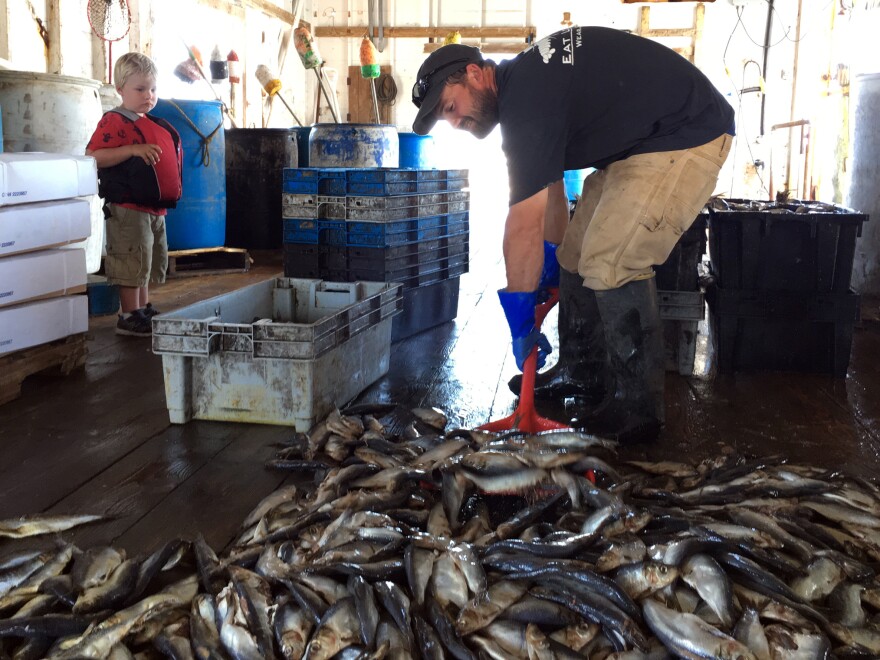Maine is the most rural state in the nation and, also, one with some of the poorest internet access. Out on the coastal islands, internet service ranges from lousy to nonexistent.
Residents of the Cranberry Isles, from lobstermen to telecommuters, are banding together to pay for costly new infrastructure they hope will help preserve a threatened way of life.
Summertime in the Cranberry Isles feels pretty idyllic. Golden badges of sun bounce from the water, backlighting lobster boats, yachts and ferries that shuttle around this small circle of unbridged islands a couple miles seaward from Acadia National Park.
But while the constant water traffic keeps the islands physically connected, residents chatting at the Great Cranberry Island Country Store are worried about a different kind of connection — internet connection.
“It’s incredibly slow and it’s weather dependent. So if there’s fog or rain or, you know, it’s dark out or whatever it doesn’t work as well,” says Samuel Donald, who manages a local boatyard.

Donald and store owner Barbara Stainton are mulling a municipal plan to radically upgrade internet service for the Cranberries, taking internet speeds from a rate that hovers around 1 megabit per second — glacial, feels like dial-up — to more useful rates as high as 100 mbps. The setup will include beaming data from a boatyard microwave antenna over to the island next door.
“It’s a perfect opportunity in a sense and also we do have a great location there,” Stainton says.
“We can see both the hill on Islesford where they are considering putting the tower and the Coast Guard station where they are considering an alternate location, so either way the boatyard is kind of an ideal spot,” Donald says.
Samuel’s looking forward to speedier dispatch of tasks that are so much easier for mainland businesses — processing payments, posting boatyard videos, uploading marketing content. Fast and reliable internet access, he says, is as indispensable today as electric or phone service.
The upgrade can’t come soon enough for Kelly Sanborn. She tried recently to make some money as a medical transcriptionist, telecommuting from her house out on the island’s edge. Her daughter Jessica’s online homework sometimes took a back seat.

“When it was just me on the internet it was pretty fast, but when more than one of us was using it went went pretty slow,” Jessica says.
“What happens when I want to work on the computer?” Kelly says.
“She takes all the internet, she unplugs it and plugs it into her computer.” Jessica says.
“I turn off the Wi-Fi, so no one else can touch it,” Kelly says with a laugh.
The gig didn’t last. When summer-people crowd the island and compete for its limited bandwidth, connections are slower than a crawl. Every time the spinning “wheel of death” appeared on her screen, Sanborn says, she saw dollars spinning away. She gave up medical transcription and took a job at the country store.
Workarounds can be found. At the local library, residents set up shop from its porch and parking lot, laptops open to tap into its Wi-Fi. The library’s dedicated internet service is the fastest on the islands, and a digital lifeline for students who attend a mainland high school, for a telecommuting graphic designer and for Rosalie Kell, an administrator for an international service mission who has been a leader in the effort to get high-speed internet to all the isles’ residences.
“My life is sitting in front of a computer,” she says.

Kell says the internet’s support for education, telemedicine, social networks and job diversity will be vital to stabilizing or expanding the isles’ year-round population. Right now there are about 150 year-round islanders, with jobs concentrated mostly in lobstering, boat building and maintaining summer homes.
“It’s about lifestyle and preserving cultures in a way that would not happen if we don’t keep up with the 21st century,” Kell says.
At the turn of the 20th century, there were 200 Maine islands with year-round residents. That has dwindled to 15 now. But community and nonprofit efforts to boost numbers are paying off on the Cranberries, where three students recently graduated from 8th grade — the most in 20 years.
It doesn’t hurt that this area of eastern Maine has become a lobstering haven as the valuable crustacean’s population shifts from warming waters farther west and south. In Islesford’s Hadlock Cove, eighth-generation resident Nick Hadlock shovels herring inside the local lobster co-op’s dock-top work shed. His four-year-old son Elliott, still safely outfitted in his red life-vest, looks on.
“I fish 800 traps,” Hadlock says. “That’s the limit for the state of Maine.”
Internet service here, he notes, is even worse than on Great Cranberry. So he supports the $1.2 million, property-tax backed bond voters from all the Cranberries approved at March town meeting, setting the new effort in motion.

Like most residents, he’d prefer that a big grant application succeeds and lets taxpayers off the hook. But if they do have to go to the well, Hadlock says, it’s justified.
“It’s real expensive but it’s a need, not necessarily a want. I think this whole island needs it — both islands. People I know work just off the computer, keeps them on the islands other than going off on a ferry back and forth and helps out actually raising kids and stuff — mother and parents can stay at home, do their job right from there,” he says.
Machias-based internet company Axiom Technologies plans to get new internet service for Islesford online before this winter, with service to the rest of the Cranberries following next year.
So far residents of 33 Maine islands and remote coastal communities have joined an effort spearheaded by the Island Institute to get robust internet service to participants within ten years. Next up: Isleboro, Isle au Haut and three of Portland’s Casco Bay Islands — Cliff, Long and Chebeague.


